Flat earth theology and crucifixation
Papal Catholicism - reflections on the funeral of John Paul IIOccasionally this inquiry is overtaken by events—the US attack on Iraq—the destruction of Falluja—the Bush 2005 Inauguration—that push aside worthy but less urgent topics. I looked at the death, funeral and eulogizing of Pope John Paul II and the election of a successor, and saw what seemed to be a uniquely transparent example of how the love of power elbows aside the power of love.
Writing about it the weeks since then, there has been a resonance for me between the papal funeral ceremonial, and the 2005 US Presidential Inauguration that I have already written about here. This is not to compare the persons but to point to the dynamic, the process of collusion and adulation within, or behind, such events. What binds such Followers to such Leaders?
In the papacy, how could such an original expression of the power of love as the Jesus messages, be so willingly diverted into its antithesis, the love of power? Even when, as in the recent papal events in Rome, love is on the agenda, is claimed to be the agenda?
The death and funeral of pope John Paul II and the election of a successor provides a promising window into what keeps domination going, into how the damage, cruelty and destruction it entails is kept out of sight.

On 6th of April, the day before Pope John Paul II's funeral, news outlets reported that 2 million Poles were on their way to Rome for the funeral, that all non-official vehicles had been banned from the city, and that it was closed to visitors; Rome was becoming a sea of people.
Many catholics saw him as saintly and waving 'Santo Subito' flags wanted to have him beatified right away. Mainstream media, especially TV, tended to eulogize Pope John Paul II and treat his demise as the loss of a great world leader,
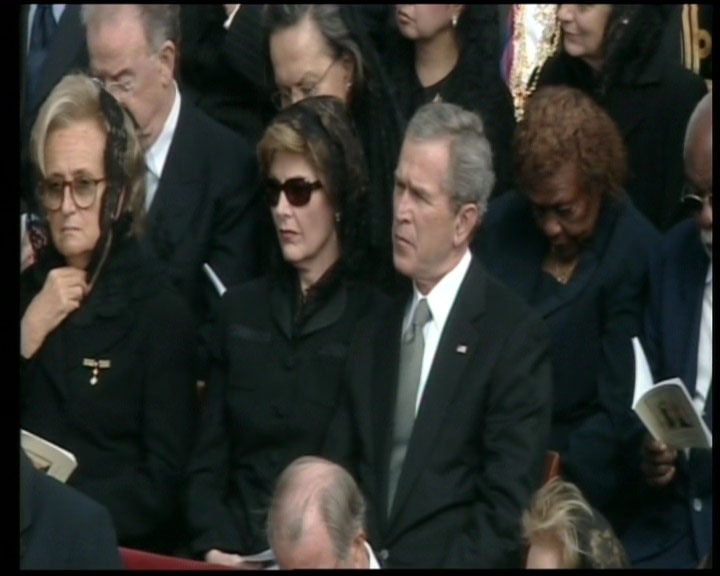
President Bush and First Lady Laura Bush showed up in Rome, and TV had shown images of them, ex-President Bush senior, and Secretary of State Condoleeza Rice sitting next to ex-President Clinton (it was hard to tell which of those two seemed the most discomfited by this experience). Three US presidents in a row in pews in St Peter's Church in Rome ‘paying their respects’.
They were joined the following day by Prince Charles, in line to become one day a competing ‘defender of the faith’, who had put back his wedding for a day, seated close to Robert Mugabe, and the reigning monarchs of 10 countries, 57 heads of State, 3 hereditary princes, 17 heads of government, the heads of 3 international organizations and representatives from 10 others, 3 spouses of heads of State, 8 vice heads of State, 6 vice prime ministers, 4 presidents of parliaments, 12 foreign ministers, 13 ministers, and ambassadors from 24 countries who had also come to the funeral.
Why did the funeral of Pope John Paul II matter so much to these visitors that they were prepared to derange their schedules to attend? Was it because, at the papal funeral, like echoed like, they were honouring an operator in their own preferred style?
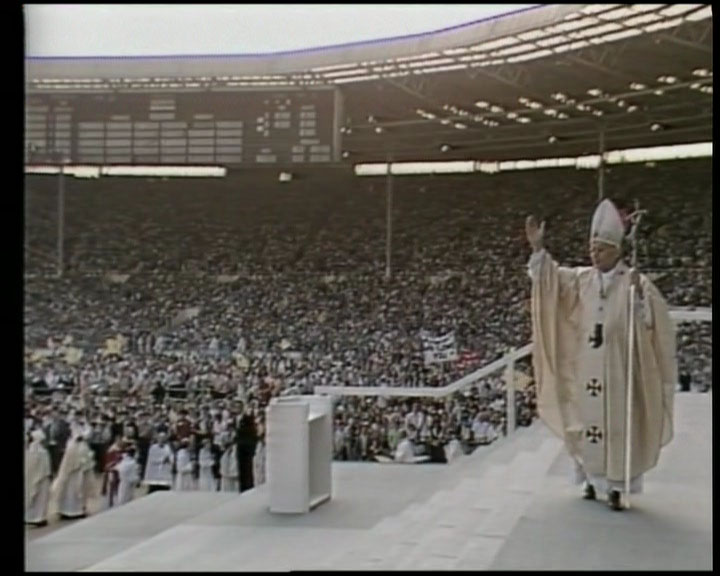
As ex-president Clinton is reported to have remarked, the late pope was ‘someone who knew how to work a crowd’.
Through my work as a psychotherapist I have from time to time become aware of some of the contradictions behind the face of papal Catholicism that was so explicitly on stage during Pope John II's funeral. Pope John was adamantly against abortion and yet the Pro-Life movement, fed by his papal authority, for all its benign focus on the value of fetal life, is the tip of the iceberg of the christian subordination of women. As though those opting for an abortion were not likely to be deeply distressed about the action they were taking. Love would see that and meet it with compassion. I've found that Papal Catholicism dogmatically spells out what it wants to see, or rather, excludes what it doesn't want to see—anything remotely reminiscent of womanly physicality, of women's bodies, of women as persons in their own right.
Feeling I needed to know more about the origins of papal catholicism, I found a good source in Elaine Pagels Adam and Eve and the Serpent. I discovered for example that St Augustine’s hugely influential take on sexuality 15 centuries ago was part of the accommodation between the previously persecuted christianity and the Rome that, following the conversion of Emperor Constantine, had become enthusiastic about christianity. Papal Catholicism continues the Augustine approach to what it means to be human and Pope John Paul II re-enforced and embodied catholic denial of the body and sexuality, re-iterating the association of carnality and sinfulness, so that for example, some catholic women die of undiagnosed breast cancer because they are unable (feel it would be sinful) to examine their breasts by touch.
The misogyny of papal Catholicism, with its scarcely concealed disgust for women's bodies—was a posture I had come across earlier in this enquiry, one very publicly and very specifically re-iterated during John Paul II's papacy. In the convoluted reasoning of this essay about why woman can never be priests, Cardinal Ratzinger, John Paul II's theological enforcer, (the celebrant of his funeral mass, and more recently, his successor as pope) denies the intrinsic value of women, half the population of the world. In an earlier Ratzinger essay explaining why homosexuality is wrong, papal Catholicism denies the intrinsic value of perhaps one seventh of the population of the world who experience themselves as gay or lesbian.
In these and other texts, I had already seen the weight of authority which the 'magisterium' of Pope John Paul II’s papacy brought to its domination of the lives of millions of people within the sphere of influence of papal Catholicism. No to sex outside marriage. No to divorce. No to contraception. No to abortion, even after rape. No to condoms as a protection against HIV/AIDS, thus ensuring countless unnecessary deaths and orphaned children. No to women priests. No to married priests, unless they are converts from other churches. Yes to ensuring young people remain ignorant about sexuality (some years ago, a doctor in a very Catholic village on the west coast of Eire told me that when local couples came to see him because they weren’t able to conceive, he usually found that was because they were practicing anal sex). Yes to naming a basketful of church worthies as saints. Yes to actively centralising the institutions of the church, so that when, a sexual-abuse scandal began to break in the US Church, the senior clerics hid the perpetrators and papered over the accusations. And the Vatican rewarded one of the key figures in the cover-up with a sinecure in Rome.
As a psychotherapist, I see the intrinsic intelligence of the body as a vital human capacity, listening to it, and trusting it, can tell us what matters, what choices are fruitful, and what are problematic or damaging. By denying this 'wisdom of the body', I began to see, papal Catholicism was able to colonize and take possession of its adherents' emotionality, consolidating its dominance by providing non-negotiable facilities such as confession for dealing with the problems thus generated. From this perspective, the sex-abuse scandals in the Catholic church look to be a poisoned fruit of the church's centuries-long history of institutional dominance and sexual repression.
Pope John Paul II also re-broadcast on all wave lengths the christian location of spirituality as outside the embodied material world, insisting that such religious notions as 'God', 'Christ', or a 'Heavenly after-life' existed independently of humankind (a similar notion, that mathematics exists independently of human mentality, has recently been challenged.) Both re-iterate the belief that there are aspects of our mental life that are outside nature, outside embodiment. 'Out there' or as the then Cardinal Ratzinger's body language demonstrated at John Paul II's funeral, 'up there'.
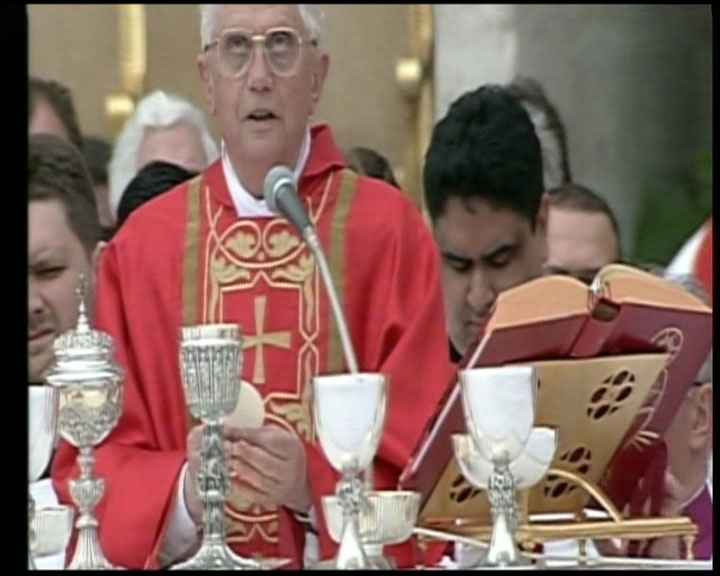
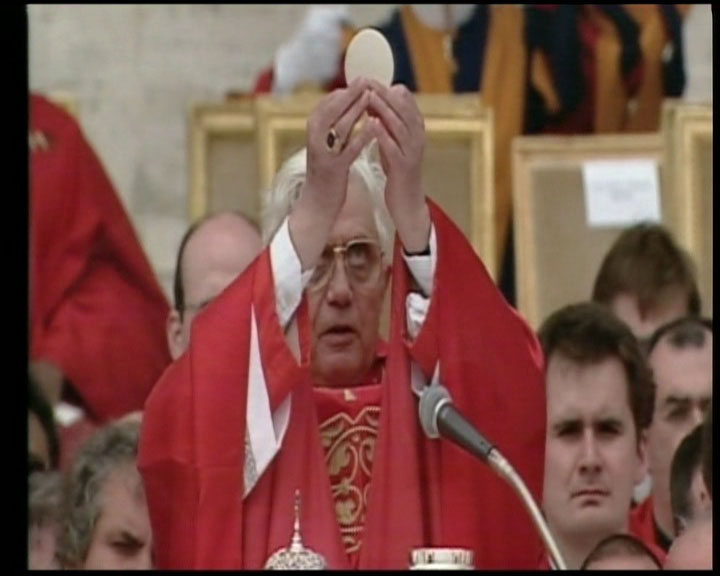
In my experience, this dissociation of the spiritual from the material and embodied, creates a very tense split in people who subscribe to it, so much so that for many adherents, the moral targets of papal Catholicism function as production schedule for the manufacture of guilt. A plethora of feelings are generated that require recourse for their resolution to the already mentioned church resources such as confession, penitence and prayer.
The more I saw of the papal funeral events, the more I realized the extent to which the papacy is an especially pure and transparent example of domination—Dominus, Domine—for papal Catholicism domination, I realized, is intrinsic, spelled out in this and countless other Vatican texts.
But was this framing of the papacy as an exemplar of domination and harm too strong? I began to think not. Looking at the big picture—broadening the frame—meant including:
The church's promotion of the Crusades, still a popular icon and a potent political factor in our times; the Inquisition, renamed but still at work and headed by Cardinal Ratzinger; the church’s historical denial of science - Copernicus, Galileo, Darwin; the church’s part in the demonizing and killing of at least eighty thousand women as ‘witches’; the church's evangelical collusion in the colonization and destruction of native cultures in Africa, America and the far east; the papacy's collusion with the German Nazi regime, including assisting the escape of Nazi war criminals after 1945 ; the continuing propagation of homophobic and misogynistic policies around contraception, abortion and AIDS. This amounts to a massive history of the abuse of power and yet a billion plus people on this earth have signed up to the catholic christian vision of human nature built on this history. Many more stand in its shadow, as off-message clerics have found down the centuries.
Matthew Fox, founded Creation Spirituality and was expelled from the Dominican order:
They gave me a list of complaints. Number one, I'm a feminist theologian. I didn't know it was a heresy to be a feminist theologian. Number two, I called God "mother." But I have proven that all the medieval mystics called God "mother." Number three was that I prefer "original blessing" over "original sin." I think they're afraid that concept could put them out of business. Number four, they said I associate too closely with indigenous people. Number five, I don't condemn homosexuals.
Many of the liberation theology priests working with the poor in South America found themselves invalidated and redeployed, or in the case of Leonardo Boff, 'silenced'.
Catholic women who have found a priestly vocation in themselves know that they are permanently barred from that role by Pope John Paul II and the people around him. (Cardinal Ratzinger, now Pope Benedict XVI, who officiated at Pope John Paul's funeral, wrote this text confirming that ordination of women priests was contrary to the 'deposit of faith'.
Non-Catholics who have fallen in love with a Catholic are very likely to find themselves negotiating, archaic and convoluted binding agreements about child-care with the church authorities before the church will endorse their love.
Juan Vaca, former US president of the Legionaries of Christ, along with 30 other seminarians under 16, claimed to have been sexually abused by Fr. Marcial Maciel founder of the order. As a Catholic Reporter editorial outlines, these men, including two university professors, a lawyer, and the order's one-time treasurer, await any sign that the Vatican is taking seriously their accusations against Fr Maciel, described as 'a dominant and domineering personality overseeing a culture in which he demanded absolute and unquestioning loyalty to himself'. Fr Marciel organised and accompanied Pope John Paul on his visits to Mexico.
As you’d expect of an inquiry, before I started I didn’t know that this study of papal Catholicism would gradually become a catalogue of such papal horribilities. Somewhat naively I thought that these views were a maverick, outsider, off-message take on papal Catholicism, even, as some people might think, a rehearsal of my poorly informed prejudice. At around this point in the writing I came across a series of articles that offered much the same perspective and that made redundant much of what else I might have gone on to say here.
I realized that in my surprise at the feistiness and depth of some of this critical writing that greeted the funeral of Pope John Paul II, I was in danger of forgetting that there was a centuries' old tradition of vigorous dissent from the papal Catholic take on the Jesus story.
What do I have to add to it?
Several related notions: that papal catholicism does indeed amount to one of the purest and most transparent forms of dominance; that it models and teaches how to install and sustain dominance; and that it is currently facing, or rather denying, a challenge on the same scale as those from Copernicus, Galileo, and Darwin.
Flat-earth theology
Behind the eulogizing of Pope John Paul II, his Catholicism hides from, and keeps hidden, the rich variety of theory and knowhow about persons and personhood that has emerged in the last hundred years or so, from those lines of human inquiry that we call psychology, psychotherapy and cognitive science.
From the vantage points of such psychological enquiry, papal Catholicism is an institution that endorses and promotes a long list of notions and behaviour that are dysfunctional and damaging to persons and human relations—it abuses power—it promotes splitting/dissociation, projection, repression, displacement, and denial definitions, more—and as we'll see, it abuses the human capacity for trance.
For all its limitations and contradictions, psychological enquiry has been one of the most beneficial items of human flourishing in the last 100 years. Why does Catholicism and Pope John Paul II's version of the papacy reject psychological knowledge about humanity? It is not due to ignorance, this well researched Vatican text about post-modern (New Age) spirituality, recognizes that many strands of psychological development provide an alternative approach to the sacred in persons and daily life but uses this insight to dismiss them. In the face of the openness and diversity of psychological theory and practice, I guess the dogmatic, flat earth theology of Catholicism feels under siege. To see where this defensive obduracy comes from and why it is so resistant to change, I found I had to back off into what I had learned about the history of childhood.
Psychohistory
Historically, childhood appears to have been severely traumatic for almost all children and this is still true in many parts of the world—think of present-day Iraqi or Palestinian children, or African children orphaned by HIV-AIDS. In History of Childhood Psychohistorian Lloyd deMause and nine other authors assembled very comprehensive historical evidence which shows that until perhaps the last 100 years, abandonment, and infanticide was common, (as abortion, it is still is) violence in education was normal, and children were variously seen as intrinsically evil, needing to be beaten into shape or punished until obedience was unquestioned, more, more i.e. that from our present day perspective, all children could be held to be severely traumatized, including by sexual abuse.
From my psychological perspective, what this amounts to is that until relatively recently, all human beings had severely painful body memories of distress dating from childhood that were driving, inhibiting or distorting their adult behaviour. Added to this, because of the near universal trauma of birth, everyone whatever their upbringing is likely to have body memories that are comparably formative.
The human bodymind has elaborate and very effective biological ways of surviving such trauma, such as the gating of pain, however, there is a high probability that the body memories of distress from such early traumatic learning will be re-stimulated by present time events. This means that developing ‘comfort zones’, circumstances and behaviors that protect us from this re-activation of traumatic body memories, are likely to be a major feature of adult daily life. Keeping this huge personal and collective history of pain out of consciousness, while at the same time trying to account for the compulsive human behaviours it drives, is the psychological soil in which Catholicism and other religions have their roots.
Christianity as psychological defence
The notion that Catholicism and other religions were defenses against embodied traumatization has been familiar to me for several decades, through the work of Frank Lake and David Wasdell, what I hadn’t begun to see until recently was how they were propagated and what kept them in place.
How was splitting/dissociation, projection, repression, displacement, and denial being promoted? Looking at papal Catholicism through the lens of psychological enquiry, I realized that there much about it was reminiscent of a hypnosis training I had done some years ago; it seemed to entail a varied menu of enthrallment, spellbinding and the casting of spells, in other words, trance induction—hypnosis. The stock in trade of stage hypnotists and politicians of all shapes and sizes, it appears to be the core ingredient of papal Catholicism too.
This felt to be a promising line of enquiry—that while claiming to be an institutional vehicle for love and caring, Catholicism deployed trance induction to keep its adherents enthralled. Charles Tart in Waking Up has called this spellbinding consensus trance.
Among the techniques prohibited to ethical hypnotists but wielded effectively in the induction of consensus trance are: the enormous amount of time devoted to the induction (years to a lifetime), the use of physical force, emotional force, love and validation, guilt, and the instinctive trust children have for their parents. As they learn myriad versions of 'the right way to do things' -- and the things not to do -- from their parents, children build and continue to maintain a mental model of the world, a filter on their reality lens that they learn to perceive everything through (except partially in dreams). The result leaves most people in an automatized daze. Tart, C. Waking Up, Boston: Shambhala, 1987
Faith
If Catholicism (along with other sects) is an institution that provides a psychosocial defence against embodied traumatization, how does it do this? How does the psycho-defence work?
The key discovery so far for me in this enquiry, has been that the entrancing element that matters, i.e. take it away and the whole edifice falls down, is ‘faith’. The Catholic consensus trance is induced and maintained through the phenomenon of ‘faith’.
Pope John Paul II was very explicit in his endorsement of the Catholic articles of faith which are available in a vast Vatican Catechism website that has 2865 items. Here is the table of contents. Some random samples:
153 ...Faith is a gift of God, a supernatural virtue infused by him.
157 Faith is certain. It is more certain than all human knowledge because it is founded on the very word of God who cannot lie.
From a psychological perspective, ‘faith’ appears to be a religio-spiritual equivalent of morphine, an anesthetic, a painkiller. Faith that papal catholicism's version of the Jesus story is revealed truth, legitimized by the supernatural event of the resurrection. So far as we hold faith in 'sin', 'repentance', 'forgiveness of sin', 'salvation' etc the church provides an pain-free end point, 'heaven.' Out of sight beneath this highly conditional promise is the subtext which tells us that pain, especially psychic pain due to political oppression, i.e. domination, is a fact of life and you better get used to it (and no matter how bad you feel it is nothing compared with being crucified). The church's global obsession with pain and suffering (see crucifixation below) absorbs (sublimates) and helps anaesthetize embodied pain but excludes enquiry into, or resolution of its origins.
Because it asserts the unique possession of god-given truth, god being all knowing, all powerful, papal Catholicism tells us there is nothing whatever that we can do to change either ourselves or the world we live in, or indeed that there is anything else worth knowing about humanity. There is only consolidation, recycling, conservation, obedience, adoration, worship, and repetition of the articles and practice of 'faith'.
143 By faith, man completely submits his intellect and his will to God. With his whole being man gives his assent to God the revealer. Sacred Scripture calls this human response to God, the author of revelation, "the obedience of faith".
Faith generation
I hadn't been long settled in seeing how the dual roles of spellbinding and faith sustain the dominance of papal Catholicism when I came across a startling pointer to the origin of christian faith.
Elaine Pagels details how in the first century after Jesus' death there were a wide variety of groups with very diverse versions of christianity. One strand of these groups, the gnostics, broadly saw christianity as matter of personal inquiry and self knowledge, gnosis, finding christ in themselves. Some of the fragments of what is known about gnostic christianity resemble core ideas of current psychology. Here is Jesus speaking to Thomas:
....For whoever has not known himself has known nothing, but whoever has known himself has simultaneously achieved knowledge about the depth of all things.
Gospel of Thomas quoted in Elaine Pagel The Gnostic Gospels p48
Abandon the search for God and creation, and similar things of that kind. Instead take yourself as the starting place. Ask who is within you who makes everything his own saying "my mind," "my heart," "my God." Learn the sources of love, joy hate and desire... If you carefully examine all these things, you will find [God] in yourself.
Hippolytus Refutation of All Heresies quoted in Elaine Pagel The Origin of Satan p167
For gnostic christianity the Jesus story was a metaphor for spiritual development, and the gospels a programme for how to do it. For them spiritual authority was personal, intimate, derived from experience. This, as you'd imagine led to a democratizing of spiritual authority with a wide range of creatively ingenious ways of taking forward the Jesus story on the basis of lived experience.
By contrast, because it is counter intuitive, contrary to commonsense, insisting that the resurrection of Jesus is literally true requires the creation of an institution of faith. As Elaine Pagels points out, because the disciples who claimed to have seen and touched the risen Christ had exclusive ownership of this version of the Jesus story, from then on acceptance into this sect of christianity required a quantum jump of faith into believing their supernatural version of the Jesus story was literally true. The handful of disciples who claimed the resurrection experience embodied unchallengeable authority. Whatever the disputes about the meaning of parables and other teachings here was proof of life after death. Secure in the faith that there was an afterlife of peace and plenty, early christians were able to endure appalling cruelty and death with an equanimity that astonished their pagan neighbours.
As Pagels tells the continuing story of the politicising of christianity, by 170 CE the 'literally supernatural' version of the Jesus story was already sedimenting into a christian orthodoxy that drew its authority from the apostolic copyright of the resurrection story. By the end of the second century a centralising, unifying, catholic, ie universal church, tracing a line of authority back to the Apostle Peter, was seeking to eliminate and suppress all other versions of the Jesus story than the supernatural one. Through this insistence on a supernatural take on the Jesus story, the seed of domination christianity was sown and began to germinate. As, in the following centuries, christian church leaders moved from being persecuted by the police to commanding the police, heresy, being off message, as we'd call it today, became a life-threatening criminal offence. Except for orthodox treatises on their errors, the gnostics disappeared from history for almost two millenia.
After being adopted by the Roman Empire following Constantine's conversion in 313 CE, in papal Catholicism began to resemble the institutional organisation we know today. Its structure of monarch, bishops, deacons, and laity, mimicked the way the Roman army was organised. By the 5th Century this alignment of authoritative spiritual power with hugely successful political power seems to have become irresistibly attractive to western Europe.
But however ecstatic the initial encounter, faith in the supernatural fades. Feeding faith, recovering faith and challenging the faithless, became essential activities of the emerging papal christianity. Hypnosis, a branch of modern psychology points to a reliable way of doing this. While about a third of the population have little capacity for trance, around a third of the population can go into a moderate trance, and another third into a very deep trance. As I see it papal christianity has accumulated a rich mix of trance inductions, ceremony, hymns, psalms, prayer, music, liturgy and theatre and repetitions of the Eucharist, that install and reinstall in the faithful the belief that the supernatural truth of papal christianity is the only truth.
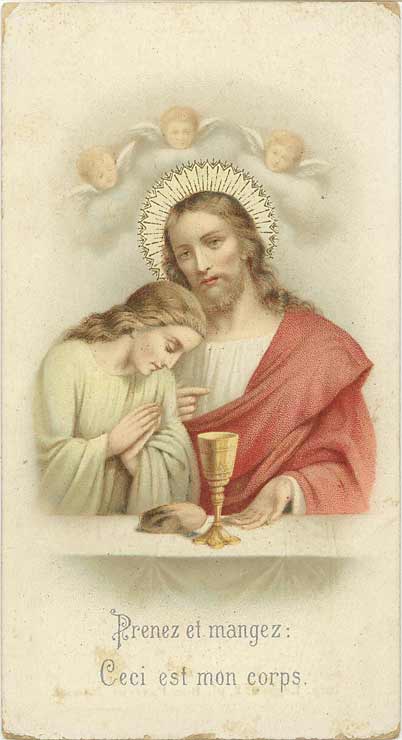
| Prenez et mangez: Ceci
est mon corps (Transl. Take and eat: This is my body) |

| Cardinal Ratzinger as he then was, celebrates mass at the funeral of Pope John II |
In a hypnotic trance the subject is abstracted from ordinary awareness and absorbed in the inner world with the feelings, images, and impressions that populate it. What those feelings, images and, impressions are depends on the expectations that are implicitly suggested—or explicitly imposed–by the hypnotist and by the hypnotic context.
The abstraction from ordinary awareness for trance inductions that install and maintain faith requires icons— objects to take projection—in papal catholicism, disciples, saints, angels, demons, etc and imaginal landscapes—churches, where the stories of faith can be re-enacted through ceremony, prayer, music, story-telling, parables, psalms, hymns and sermons. Catholicism provides a rich tapestry of both icons and landscapes.
Icons
I have come to see papal Catholicism's iconic images of disciples, saints, martyrs, the virgin mother and her son, plus the characters of the bible stories, as ’psychic dolls’, or 'alters' as Lloyd deMause calls them. They are created and re-created as generation after generation of worshipers, regulated by the fathers who administer the church, direct multiple projections of devotion, adoration, obedience and faith towards them. Here are a handful of examples collected in the last couple of years.

| O Jesus que
nous adorons maintenant caché dans l'hostie donnez à nos
yeux de contempler un jour votre visage dans la splendeur de
votre gloire (transl. O Jesus whom we adore at present hidden in the Host. Grant to our eyes one day to see your face in the spendour of your glory. |
.
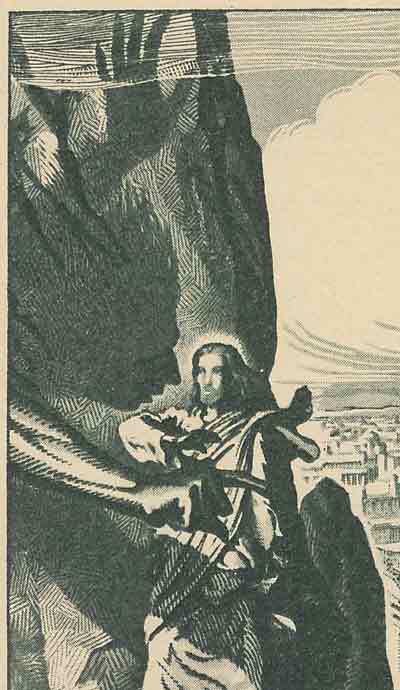
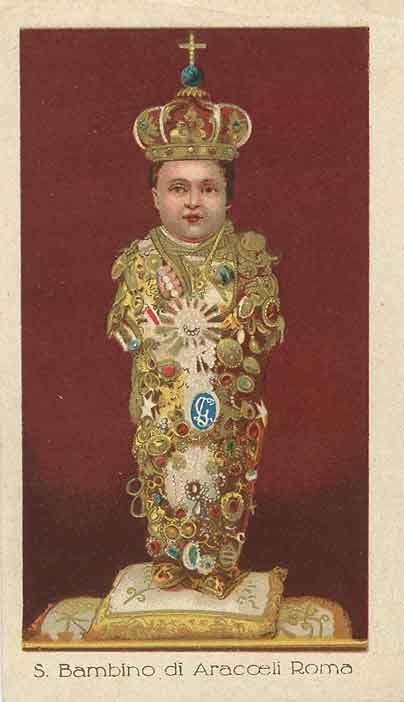
| In this mass card (left) Jesus struggles to free himself from the Satan's temptations. | St Bambino
di Aracceli Roma |
Crucifixation
Foremost of the icons of catholic christianity is the crucifixion of Jesus of Nazareth—along with the resurrection, the central image around which papal catholicism rotates.


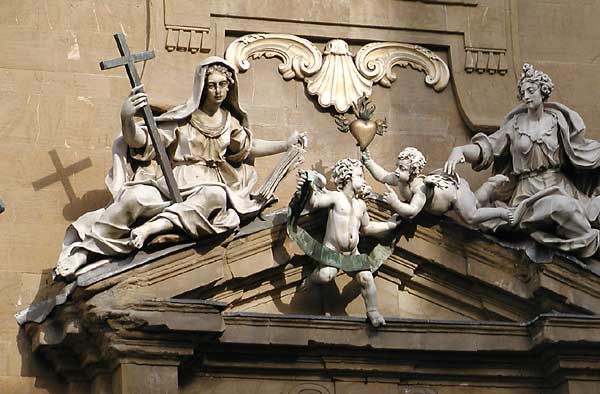

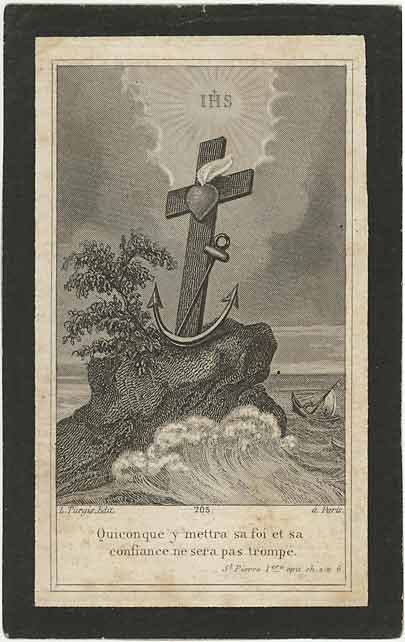
| Sancta
Rita, rogad por nosotros Transl. Saint Rita pray for us |
Quiconque y
mettra sa foi et sa confiancene sera pas trompé
Transl. Those who put their trust in me will never be betrayed. |
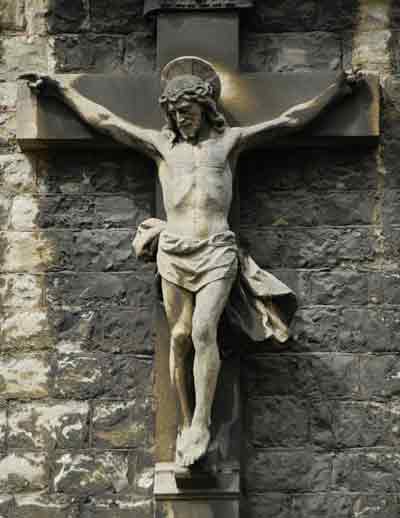
This crucifixion image that commemorates
the dead of the Great War, is on a church wall
200 metres from where I’m writing. Every
time I leave and return home I am confronted
with this man's suffering and agony.

This crucifix is from a web catalogue that
has a hundred or more to choose from.
Why is the crucifixion of Jesus such a potent image for christians?
One of the lenses of psychology—pre- and prenatal psychology and birthwork—argues that the crucifixion of Jesus of Nazareth has become a profoundly potent icon because it echoes, resonates with, and makes sense of the acute pain due to trauma, held in the bodies of people down the centuries, especially and particularly, the pain of being born. David Wasdell provides a detailed account of this here
David Wasdell
The resolution of this universal human experience as we leave the dark universe of the mother's body and enter the light universe of daily life—out of darkness into light—is a recurring theme across christianity:
“ a light that shines in the darkness, a light that darkness could not overpower”. (Jn. 1:5).Most Rev John Magee, Bishop of Cloyne
Rev. Asa Mahan President Oberlin College 1835

In this de-construction of the Jesus story, the ‘crown of thorns’ carries an additional iconic resonance, with the acute foetal pain involved in the transit of the cervical vaginal exit from the womb.
The bestseller on this Crown of Thorns web site is a full size crown of thorns guaranteed to have been made from a descendant of the original Jerusalem thorn bush
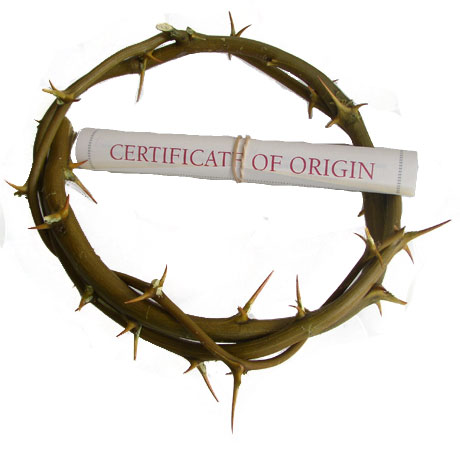
After the resurrection, for the faithful, supernatural proof that there is life after death, Jesus ascends into Heaven. Heaven, the residence of God and the Holy Spirit holds the promise of a suffering-free existence.

to receive aborted foetuses rescued by angels
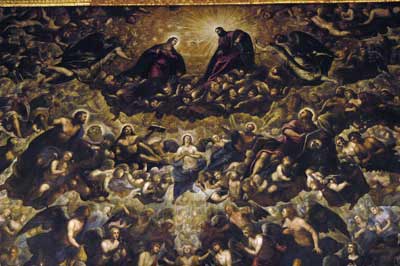
Complementary to Heaven, there is the notion of Hell, an imaginal landscape of eternal pain and punishment. This resonates with, and gives a name to, the galaxy of painful bodily experiences of pain due to foetal distress and abusive child rearing and the accumulations of what historically, for many people, seems often to have been a hellish experience of daily life.
.
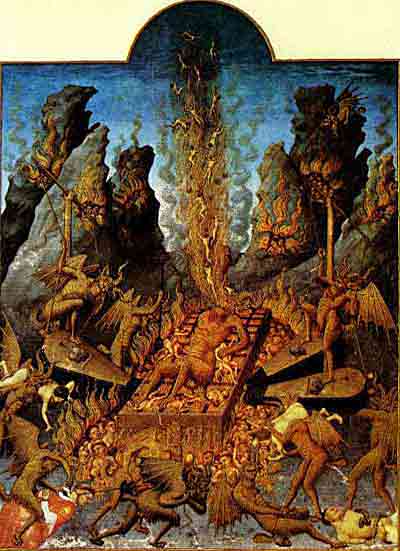
Duc de Berry Book of Hours
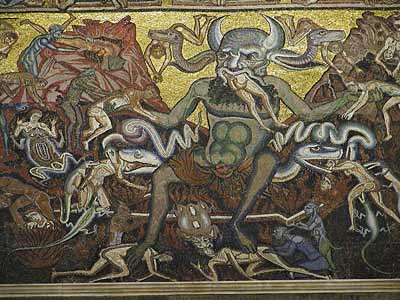
This mosaic of Hell is in the Baptistry in Florence
Alongside all this sits, what I have recently begun to recognize as the undeclared pantheism of christian sainthood.
Top of the list Mary, the 'good mother' that, as psychohistory shows, historically few, if anyone, had. Until relatively recent times absent fathers were normality, mothers did the enforcing and socialising of children. Mary provided an idealized mother who can be appealed to for the sympathy, support, commiseration and caring that was missing from either a person's childhood, or their daily life, or both. This seems to have been especially relevant for the multitudes of women struggling to survive hurts, injustices and grief in a male dominant world.

'May Our Lady model of purity, bestower of graces,
obtain for you all heavenly gifts.
Mary, the only high visibility icon of papal christianity that has feminine resonance, is loaded with contradictions, beginning with the virgin pregnancy—could claiming divine intercourse have been a neat way of avoiding being stoned to death for adultery? And to delight misogynistic eyes, here is a woman undefiled by sex. How were the poor faithful supposed to go forth and multiply?
This ceramic of the Virgin Mary belongs to a home for abandoned children in Florence, open for four centuries until 1870. It seeks to entrance inmates into accepting two of the prominent features of papal christianity: hubris and servility.
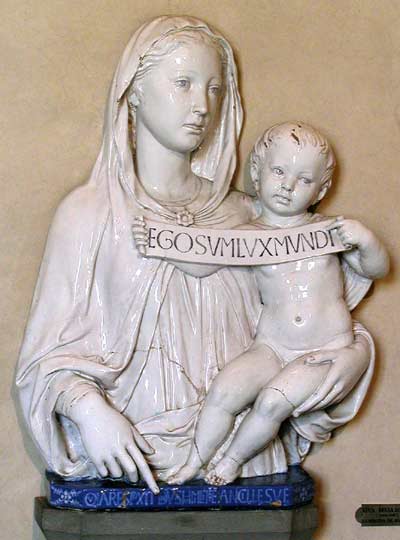
| The Christ child holds a
scroll reading 'I am the light of the
world,' Mary's finger points to a message that tells women that 'the Lord has been mindful of the humble state of his servant'. |
And then there are the iconic 'fathers', the Father in Heaven and the Holy Father... and the father in the parish church.
Imaginal landscapes
The trance inductions of papal Catholicism, are centred on churches, theatres where its rich imaginal landscape of liturgy and ceremony are organized and orchestrated.
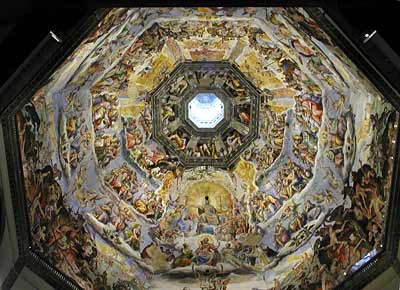
The Duomo Florence
The population of this landscape includes: (note the capitalization signaling iconic value) a Holy Trinity, a Holy Ghost, a Holy Book, a Son, and a Father, the Virgin Mary, The Lord, Saviour, The Devil, Satan, Angels, Saints, Miracles, a Virgin birth, Purgatory, Hell, Life after Death, A Garden of Eden, and Heaven.
But when on the tourist trail we visit the imaginal spaces of ancient i.e. pre-protestant churches and cathedrals, there is little to inform us that historically, for the general population, hearing mass in the churches of christendom was to be witnessing a remote ceremony, with chanting, bells and incense, conducted by priests distant and out of sight behind the altar screens. A process that underlined the kind of ambiguity that an effective screen for projection requires if it is to keep alive adherents' psychic dolls.
Going to church—'hearing mass', taking communion, and contemplating the panoply of saints, having a Son of God who shares our pain, having a Book that details what is right and true about life, and even that there is an end to pain in the heavenly after-life to come—glued in place by the trance inductions of faith—all these provide a spell-binding set of potent iconic characters set in a rich imaginal landscape. Together they form a very effective receptacle for the projection of inner turmoil and pain.
Dominance damages
Historically papal Catholicism may have been an adequate way of meeting the survival needs of, by modern standards, comprehensively traumatized populations (for details see Lloyd deMause: The Evolution of Childrearing). In the light of current knowledge about persons and how they develop, Catholicism’s archaic, pre-psychological insistence on the exclusive ownership of the Truth about persons now seems to me equally comprehensively damaging:
- in direct contradiction of the Jesus message of ‘love thy neighbour as thyself’, papal Catholicism models and broadcasts dominance, legitimizing it as natural and inevitable, perpetuating the damage that arises due to such abuses of power wherever they occur;
- papal catholicism is palliative not transformative;
- the group consensus trance it embodies is the antithesis of inquiry and disallows innovation;
- despite all this, too many world leaders still give adulatory attention to papal Catholicism and some are, at least notionally, signed up to it.
- the institutional culture papal Catholicism models and promotes versions of human power relations that, alongside demeaning and side-lining women, half of the population of the world, helps continue, by other means, the European colonization of the South. The Vatican curia has 114 white western Cardinals (38 of them from Italy) 24 from Africa and the middle and far east and 28 from 'Latin' America. And might it be racist too? A devout catholic I know, recently returned from Poland, reported that the grass roots view there on the recent election of Cardinal Ratzinger as successor to John Paul II, was that 'it was a choice between a sick man and a black man, and of course the sick man won'.
- the papal monarchy, like other monarchies before and after it, is damaging because it denies self determination, the power of persons themselves to find, or create, a spirituality that meets their needs, rather than the needs pre-ordained by a remote, dogmatic institution. Especially, through the splitting of spirit from body, it also tends to close off the essential daily task of finding of the sacred in the secular, a task that I feel is now vital for human and ecological survival.
- papal Catholicism's notion of ‘original sin’, an artifact of the political accommodation between christianity and imperial Rome and its companion, ‘evil’, contribute to a profoundly pessimistic model of human nature.
- Buying into the trance inductions of crucifixation and ‘original sin’ and ‘evil’, supports 'bystanding' the damage that cultures of domination such as papal Catholicism entail. We don't have to take responsibility for interrupting the ugly truth that childhood violence and sexual abuse often lay down intolerable bodymind pain that some people feel compelled to re-enact in violence on others through murder, assassination and warfare. We can collude with others in failing to take account of the extent to which cultures of domination such as papal Catholicism are taking us in the direction of ecological disaster.
To summarize, the Catholicism of John Paul II is damaging because it provides a consensus group trance way of containing or defending ourselves against the hurts, humiliations, confusion, sadness, fear and anger that we suffered when we were young, and maybe not so young, and which we carry with us as body memories and thus body posture, character, values, beliefs, and personality formation. The earlier and more traumatic the hurt, the deeper it takes root in the formation of personhood and the more likely it is that current events that echo the original situation will 're-stimulate'—trigger regression in us to experiencing that hurt again. Since none us wants this, we do what we can to keep away from such situations, through aversion, a built in compulsive flinch/flight from, or a compulsive, needy clinging on to anything or anyone that promises to keep us out of the early traumatic feeling. Papal Catholicism does this very well, ensuring that we don't develop the emotional competence that would enable us to attend to and resolve the occluded history rather than hide from it.
Flight from modernity
Papal Catholicism, an arm of 5th century imperial Rome that intrudes into the 21st century, is understandably in flight from modernity, it is intentionally a pre-modern, pre-scientific, pre-psychological institution. This would be fine by me if it was only one voice at the global meeting of minds but this is a loud bullying voice, ruthless in its love of power.
Its compulsive holding to its archaic political origins denies, and is intended to deny, the opening up of human rights, the extensions of democracy and human knowledge of the last century. It denies this because to embrace it would undermine its dominance. And yet what at root is the modernity it denies? Yes, there are still injustices and contradictions, but the developed world features innumerable interlocking technical and ‘knowledge cultures’ —traditions of research and inquiry—built on several centuries of human research, in physics, mathematics, astronomy, biology, medicine, sociology and psychology. Even though corporate colonization of knowledge, or strangulation of it at birth, is common, the fruits of these cultures of inquiry amount to an astonishing flowering of humankind that is becoming very widely diffused and enjoyed.
One of the fruits of such enquiry is the sharpened perception that single big ideas—single accounts of how and why—are likely to denote tyranny—the imprisonment of intelligence, not infrequently in steel and concrete gaols. Papal catholicism is ultimately in denial of the realization that at this point in history the intellectual territory of single big ideas is irreversibly mutating into the uncertain landscape of post-modernity, where human survival depends on meaning and value being more and more negotiated rather than dispensed. A world view that paradoxically appears to closely resemble that of 1st century gnostic christianity.
And yet threaded through these, albeit improved, accounts of the worlds we inhabit, domination still seems to prevail, and the accumulations of damage due to dominance-driven living continue to sediment into the impending catastrophe of humanly generated global warming.
Which brings us back to papal Catholicism. In modelling top down hierarchical bullying, both institutionally and in its compelling trance inductions, papal Catholicism insists on a fatally attractive apolitical equation—that change, particularly if it involves social justice, is not only impossible but wrong. This is not to blame papal Catholicism for our impending ecological threat but to see its ethos of dominance as feeding the imperial, bullying, colonizing approach to nature which, literally in the name of god, is a precursor of the ecological damage we are confronting today. While promising a solution to human suffering through obedience to the tenets of faith, it actually epitomizes the over-arching problem humankind faces—that dominance damages.
Conclusion - Brand managing human nature
In claiming possession of a uniquely ‘true’, or ‘correct’ vision of spiritual truth while denying its psychosocial origins, the papacy of John Paul II propagates a way of framing human nature that institutionalizes, behind declarations of the power of love, the reality of the love of power. However papal Catholicism is not only a living embodiment of the love of power, it also teaches us how to manage political power. The Vatican, proprietor of christianity, perhaps the biggest and first among all brands, was an early, if not the first, developer of brand management,
How does this apply to papal Catholicism? Brand management functions through attaching an entrancing feeling or quality to a product or service. In the case of papal catholicism consumer attention has already been flooded by centuries of positive feedback loops (the more we hear of a notion or an idea, the more it seems to be true) through preaching, teaching and evangelizing christianity. Protecting the brand through iconic resonance with saints and the 'deposit of faith' as the Vatican calls it, plus re-iterations of exclusivity and the elimination of rivals and dissent—ensures that papal catholicism holds its place in the spiritual marketplace.
Because so many people take dominance in human relations to be natural, in such a brand management approach to truth-telling, the trance inductions that get financed and institutionalized, such as the papacy that we examine here, seem overwhelmingly likely to be those that shut down open enquiry and that preserve, extend and entrench the power status quo, typically that of top down authoritarian relating.
The phenomena of mass communication of the last 100 years, epitomized by the media coverage of John Paul II’s funeral, challenge papal Catholicism by bringing other world views into catholic living rooms but it also hugely amplifies its capacity to promote its brand of christianity—to generate, sustain, and deepen its spellbinding trance inductions. Through them, huge populations in post-colonial South America, Africa and the Far East have come to subscribe to a damagingly narrow range of intrinsically western notions about what is human and natural about humankind and the planet we inhabit.
So far as it is domination that is regarded as natural and inevitable, this amplifies an especially dangerous situation. Not least because it provides a parallel 'moral' model supporting that of the George W. Bush administration, the US military corporate imperium and its globalizing allies, who are also presently trying to impose the godified righteousness of a 'new world order' on the entire planet, while ignoring the over-arching threat of global warming.
In an earlier draft of this piece (most of this text was written in the days after Pope John Paul's funeral) I wrote:
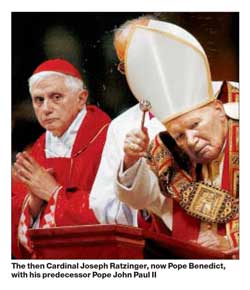
Leaving aside the religious faith dimensions, or the mafia qualities of the Vatican curia, behind all the spells and incantations, these men wearing the silk threads of infallibility on moral issues, are in the modern corporate business of defining what is, or is not, human nature, what behaviors and relationships are human and natural. For any such power, to be concentrated locally as it is in Rome with the global reach of international papal Catholicism, especially if it equates eternal with inevitable, is an ever-present danger. Domination damages.
In case you are inclined to see this present line of enquiry as inadequately rooted in other research, I'll end with George Lakoff’s almost poetic unravelling of the christian faith consensus trance as a metaphor.
The metaphor of Moral Order fits naturally with the metaphor of Moral Authority, as well as with the literal parental authority central to the Strict Father family. This metaphor is based on a folk theory of the natural order:
The natural order is the order of dominance that occurs in the world. Examples of the natural order are as follows:
God is naturally more powerful than people.
People are naturally more powerful than animals and plants and natural objects.
Adults are naturally more powerful than children. Men are naturally more powerful than women.
The metaphor of Moral Order sees this natural hierarchy of power as moral. The metaphor can be stated simply as:
• The Moral Order Is the Natural Order.
This metaphor transforms the folk hierarchy of "natural" power relations into a hierarchy of moral authority:
God has moral authority over people.
People have moral authority over nature (animals, plants, and natural objects).
Adults have moral authority over children.
Men have moral authority over women.
.....
The Moral Order metaphor plays a crucial role in an important interpretation of the Judeo-Christian religious tradition. It is an entailment of this metaphor that God cares about human beings in the same way as parents care about their children or shepherds care about their flocks or farmers care about their crops. Logically, after all, there is no reason that a supreme being should care about lesser beings. But if the order of dominance is a moral order, then God does care about mere mortals; setting the rules and enforcing them is how he shows he cares, and in return for his care, we owe him obedience.
The consequences of the metaphor of Moral Order are enormous, even outside religion. It legitimates a certain class of existing power relations as being natural and therefore moral, and thus makes social movements like feminism appear unnatural and therefore counter to the moral order. It legitimates certain views of nature, e.g., nature as a resource for human use and, correspondingly, man as steward over nature. Accordingly, it delegitimizes other views of nature, e.g., those in which nature has inherent value .
George Lakoff Moral Politics 1996
__________________________________________
Media comment on the papacy of Pope John II
Polly Toynbee 8th April 2005 ... a modern, potent force for cruelty and hypocrisy.
Here is a long, well-researched Mother Jones article detailing the CIA's involvement with the Vatican from WWII on.
Jonathan Steele Friday April 8, 2005 We are rewriting the history of communism's collapse. It was Gorbachev, not the Pope, who brought the system down
Terry Eagleton The Pope has blood on his hands The Pope did great damage to the church, and to countless Catholics.
Matthew Fox Reflections on Pope John Paul 2
Peter and Margaret Hebblethwaite, and Peter Stanford John Paul II Obituary:
The Guardian
Ellen Goodman Washington Post Writers Group Pope John Paul II
Cardinal Ratzinger Fan Club Yes, there is one! Here is a sample extract:
Some blog reflections on the papacy that are more intelligent than the title suggests.
Joan Chittister, OSB, Antigone or Ismene: the new choice
Paul Collins, Australian theologian and broadcaster argued at the intriguingly titled We are Church group press conference during papal election week that:
“the
legacy of John Paul II... was
“reactionary, with no sense of contemporary theology, biblical studies
and church history.” There was “no demonstrated understanding of
the
historical conditioning that gives context to all philosophy, ethics,
and theology.”
...the curia itself must be abolished. As a relatively late invention of the 17 century, spawned in a period of absolute monarchies, the centralized departmental structure “is not constructed in a way that can respond to modern questions.”
Nor, Collins implied, can they, coming out of a mind set formed in a royal court, reform themselves... the health of the church… is in danger of suffering from too much papalism, excessive centralization beyond any historical norm… and a male-centeredness that makes invisible half the population of the world.
Professor Adriano Valerio, a professor of Church History at the University of Naples and President of the European Society of Women in Theological Research, pointed out at a the same press conference that there are 600 women Catholic theologians in Europe who are studiously ignored by the Vatican and can only have a voice in secular academia:And then a few weeks later, there was the reception in some media of John Paul II's successor.
Pope Benedict XVI and the “Dictatorship of Relativism”
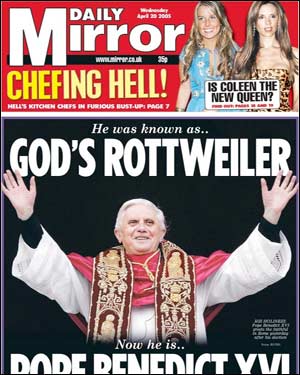
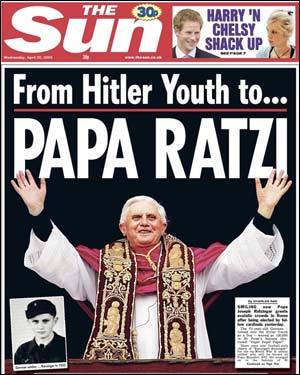
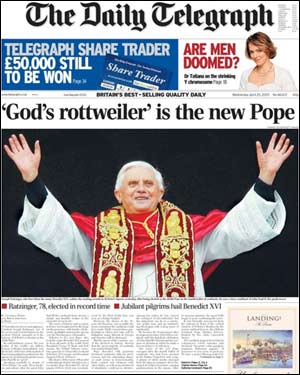
There are 0 writeback comments for this entry
posted at: 12:19 | permanent link to this entry